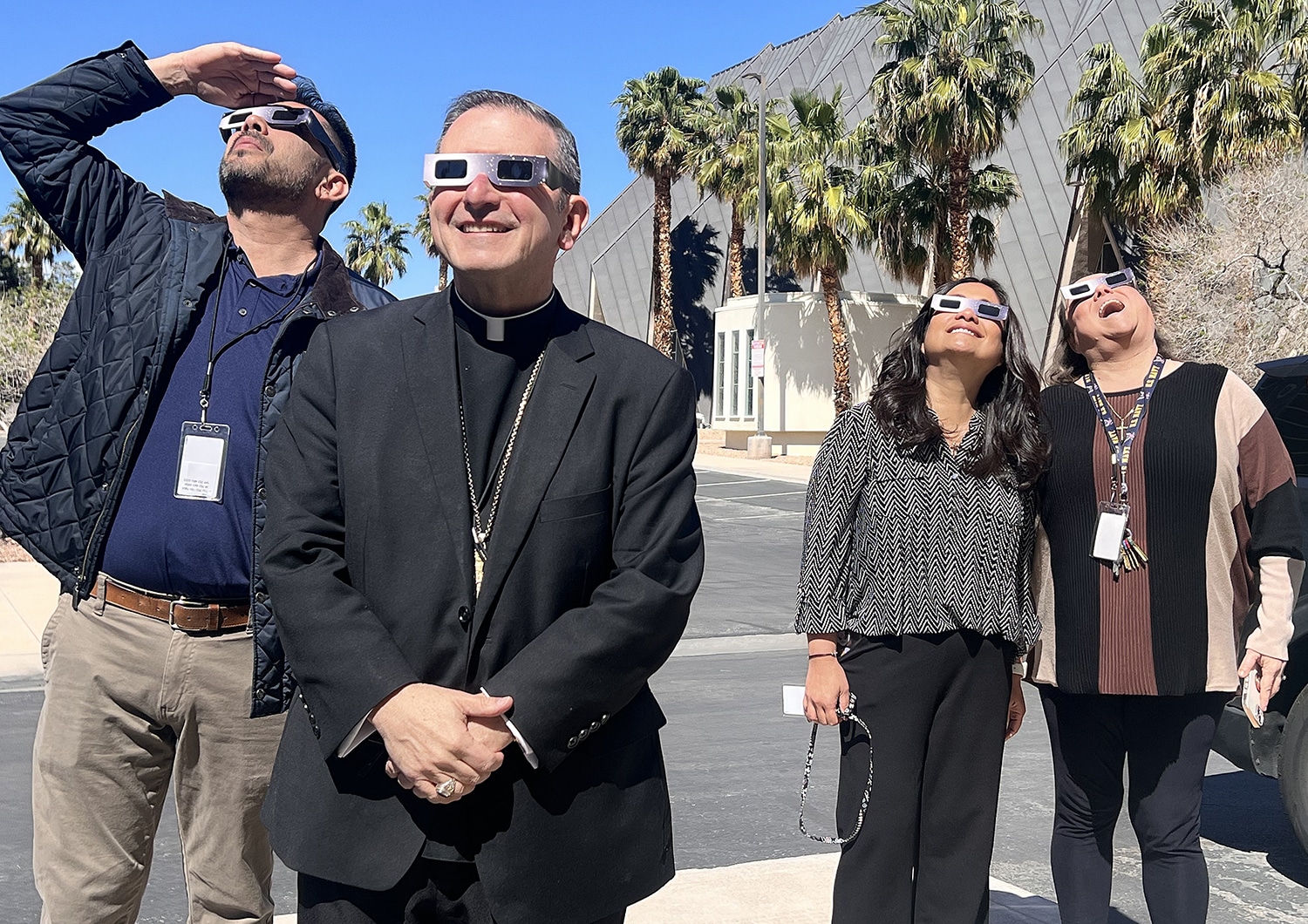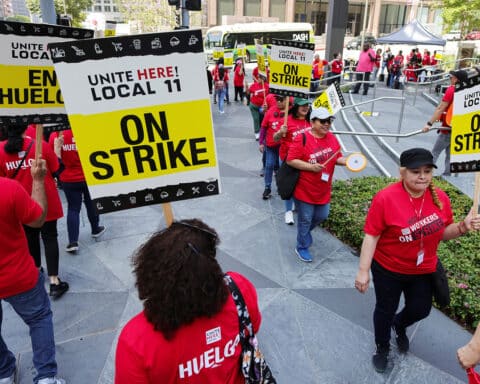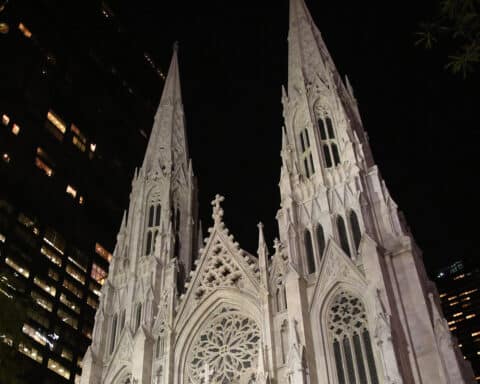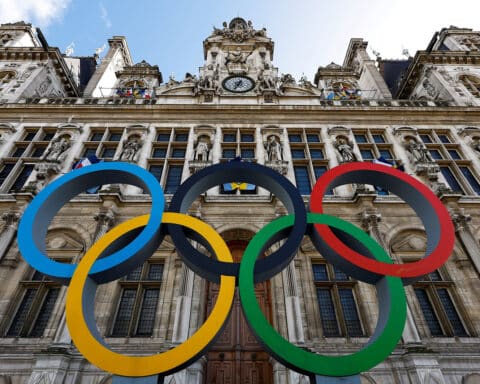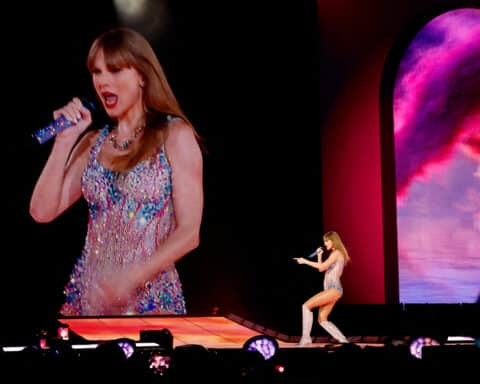(OSV News) — The Great North American Eclipse has come and gone into astronomical history — and, according to NASA, the mainland United States will not see another total solar eclipse until 2044.
Approximately 200 million people in the U.S. were in the phenomenon’s path, which stretched from Texas to Maine — but views of a total or partial eclipse depended on the weather permitting.
Las Vegas: Desert sky view
In the Archdiocese of Las Vegas, weather did permit — so Auxiliary Bishop Gregory W. Gordon and the chancery staff headed outside with their eclipse-viewing glasses.
“With our bright blue desert skies above us, my thoughts went first to the hymn, the ‘Canticle of the Creatures,’ composed by St. Francis of Assisi,” Bishop Gordon told OSV News. “In it, the first creatures of God for which the saint praises the Lord — ‘Laudato si‘, mi Signore’ — are the sun and the moon, ‘brother son’ and ‘sister moon.’ These heavenly creatures seemed to be greeting each other yesterday.”
The Las Vegas area experienced 51% magnitude, or a partial eclipse. In a solar eclipse, the magnitude is the fraction of the sun’s diameter that is covered by the moon.
“The eclipse also invited me to ponder the Scriptures,” Bishop Gordon said, “specifically Psalm 8: ‘When I see your heavens, the work of your hands, the moon and the stars you set in place …’ We were truly beholding the handiwork of God.”
The eclipse also elicited a prayer from Bishop Gordon.
Houston: A glimpse despite cloudiness
“My prayer in response to this celestial phenomenon which we were blessed to witness is that all may look up and see with eyes of faith the creator of both sun and moon, God, Our Father,” he offered. “And that we might also come to recognize that the pinnacle of his creation is the human person, called each day, solar eclipse or not, to be ‘living in his most holy will.'”
In Houston, where the Johnson Space Center has for more than 60 years served as NASA’s headquarters for sending humans into space, Jo Ann Zuñiga, media relations manager for the Archdiocese of Galveston-Houston, was celebrating both her birthday and the eclipse.
“Despite some cloudiness, God gave us a peek of his great creations!” she told OSV News. “Best birthday present ever!”
Houston was not in the path of totality — where onlookers could witness the moon completely block the sun — but it was nonetheless in line to see 93%-95% coverage.
Washington D.C.: Darkness and light
Father Edward Hathaway, rector of the Basilica of St. Mary in Alexandria, Virginia, just outside of Washington, remarked on the significance of a major date on the liturgical calendar coinciding with the celestial event.
“The eclipse falling on the feast of the Annunciation reminds us of the darkness that there would be apart from Christ who is our true light,” noted Father Hathaway, whose 229-year-old parish is the first Catholic parish in Virginia.
The Washington suburbs were dazzled by 87% totality.
Chicago: An astrophysicist’s perspective of eclipse
In Chicago, Father John Kartje, rector and president of the University of St. Mary of the Lake/Mundelein Seminary in Illinois, who also holds a doctorate in astrophysics from the University of Chicago, wasn’t able to witness totality, but was nonetheless treated to a rather impressive astronomical show, with 94% of the sun covering the moon.
“I remained in Chicago, but spoke with many people who had traveled south to experience totality,” Father Kartje told OSV News. “For me, it was a source of awe and wonder to witness the impact that such an extraordinary natural phenomenon can have on us, who all too often take the cosmos for granted.”
Father Kartje observed that the eclipse had the effect of bringing people together.
“The event had a way of drawing together many disparate populations and demographic groups: gathered in the same parking lot or field, all wanting to experience the same wonder — the glory of creation can be a powerful unifying agent,” he said.
Whether a trained astrophysicist, like Father Kartje, or a casual stargazer, a total eclipse is the ultimate experience — and he noted that some Chicago residents found themselves disappointed with 94% totality.
That “sounds like a lot, and it is — but even a sliver of visible sun is more than enough to keep it feeling like daylight; nothing at all like the blackness of totality,” Father Kartje explained.
Still, he was there to console anyone who felt slightly disenchanted.
“I told them that it’s kind of like God’s glory,” Father Kartje emphasized. “Just a ray or two is easily enough to transform our lives.”

